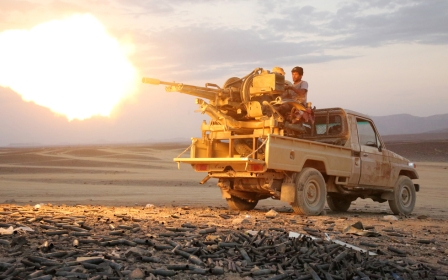Scores killed as Yemen peace talks near conclusion

Fierce fighting between coalition-backed government forces and Houthi rebels in Yemen produced heavy casualties on Saturday amid UN alarm at ceasefire violations ahead of a final day of peace talks in Switzerland.
At least 68 people were killed near the northern town of Haradh, which was overrun by loyalists on Thursday, military and tribal sources said.
The casualties were 28 troops and 40 Houthi rebels, with another 50 Houthi and 40 loyalists wounded.
The United Nations confirmed that Sunday would mark the final day of talks.
UN special envoy Ismail Ould Cheikh Ahmed plans to hold a news conference later on Sunday in Bern "on the conclusion of the Yemen peace talks held this week in Switzerland", a statement said.
Meanwhile, loyalist forces had advanced within 40km of rebel-held capital Sanaa as they pressed their advance against the insurgents, military sources said, in an apparent disregard of the UN-brokered ceasefire.
Pro-government forces supported by a Saudi-led coalition had kept up pressure in Sanaa province's Nihm district after significant gains in Marib province east of the capital.
The forces loyal to President Abd Rabbu Mansour Hadi, and allied tribes in the area, have laid siege to Nihm's Fardha military base northeast of the capital.
Despite the proximity, the roughly 40km separating Nihm from Sanaa is mostly rugged mountainous terrain.
Government forces advance
On Friday, loyalists seized Hazm, capital of Jawf province, to the northeast of Sanaa.
By Saturday, they had extended their gains in Jawf, capturing Al-Ghayl and Al-Maton districts, according to sources in the pro-Hadi Popular Resistance militia.
The two areas fell after clashes between advancing forces and rebels and renegade troops loyal to former president Ali Abdullah Saleh, said Ameen al-Ukaymi, a tribal chief of the Popular Resistance.
Government forces are now heading west towards the contiguous rebel strongholds of Amran and Saada provinces, immediately north of the capital, Ukaymi said.
Military sources said coalition-backed pro-Hadi forces reinforced Hazm Saturday, including with tanks and other armoured vehicles.
The operations took place despite the ceasefire that has been repeatedly violated since it came into force as the UN-sponsored talks opened Tuesday in Switzerland.
Cheikh Ahmed's expressed, "deep concern at the numerous reports of violations of the cessation of hostilities", his office said late on Friday.
His comments came after the pro-government forces seized two northern towns and the rebels fired two ballistic missiles at Saudi Arabia.
He "urges all parties to respect this agreement and allow unhindered access for the delivery of humanitarian assistance to the most affected districts of Yemen," the statement said.
It was issued after a fourth day of rocky peace talks, during which the special envoy "held several sessions with the participants", the statement added.
The discussions "focused mostly on security issues in Yemen, in light of the alarming developments on the ground," it said, stressing that both sides had "renewed their commitment for a ceasefire".
"A coordination and de-escalation committee was created to strengthen adherence to the cessation of hostilities," the statement said.
The UN announced a first breakthrough in the talks on Thursday, saying the sides had agreed to "allow for a full and immediate resumption of humanitarian assistance" in the flashpoint Yemeni city of Taiz.
But a local group, the Humanitarian Relief Coalition, said no UN aid had reached the city, and accused rebels of blocking aid deliveries to areas where Hadi loyalists are holed up.
Yemen's conflict began in September 2014, when the Houthis advanced from their northern strongholds to occupy the capital Sanaa.
It has escalated dramatically since Saudi-led air strikes against the rebels began in March, with more than 5,800 people killed and more than 27,000 wounded since then, according to UN figures.
Middle East Eye propose une couverture et une analyse indépendantes et incomparables du Moyen-Orient, de l’Afrique du Nord et d’autres régions du monde. Pour en savoir plus sur la reprise de ce contenu et les frais qui s’appliquent, veuillez remplir ce formulaire [en anglais]. Pour en savoir plus sur MEE, cliquez ici [en anglais].




